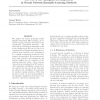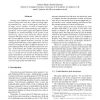109 search results - page 9 / 22 » When Are Behaviour Networks Well-Behaved |
CIBB
2009
13 years 8 months ago
2009
Modelling activities in molecular biology face the difficulty of prediction to link molecular knowledge with cell phenotypes. Even when the interaction graph between molecules is k...
HICSS
2005
IEEE
14 years 29 days ago
2005
IEEE
1 On the Internet, digitally active small and medium sized enterprises (SME) face numerous security risks. When SMEs join networks, business ideas and malicious activities may inte...
ICML
2003
IEEE
14 years 8 months ago
2003
IEEE
We analyze the formal grounding behind Negative Correlation (NC) Learning, an ensemble learning technique developed in the evolutionary computation literature. We show that by rem...
AINA
2009
IEEE
14 years 14 days ago
2009
IEEE
Keeping router buffering low helps minimise delay (as well as keeping router costs low), whilst increasing buffering minimises loss. This is a trade-off for which there is no sing...
IWQOS
2001
Springer
13 years 11 months ago
2001
Springer
To create acceptable levels of Quality of Service (QoS), designers need to be able to predict users’ behaviour in response to different levels of QoS. However, predicting behavio...


